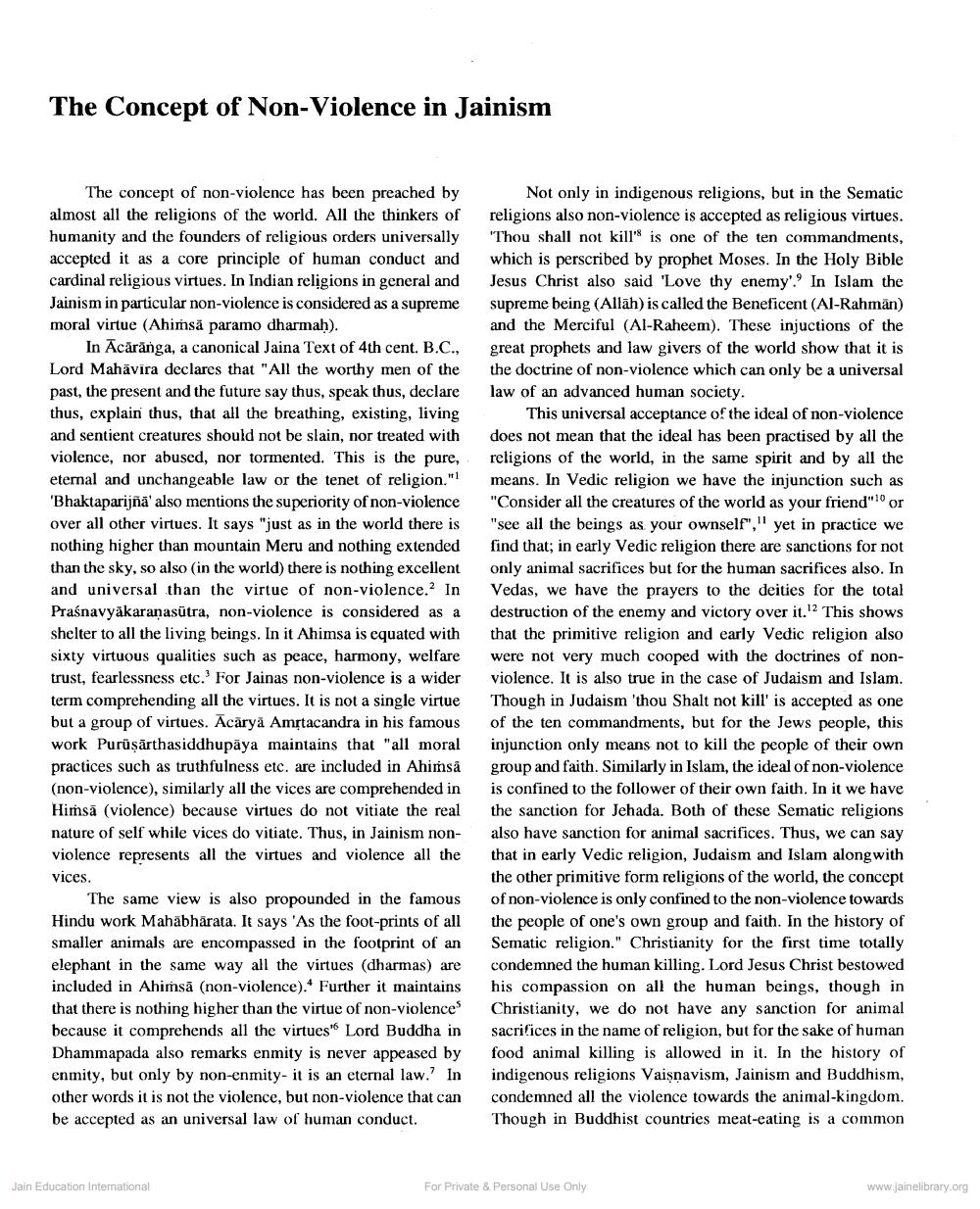________________
The Concept of Non-Violence in Jainism
The concept of non-violence has been preached by almost all the religions of the world. All the thinkers of humanity and the founders of religious orders universally accepted it as a core principle of human conduct and cardinal religious virtues. In Indian religions in general and Jainism in particular non-violence is considered as a supreme moral virtue (Ahimsă paramo dharmah).
In Ācāranga, a canonical Jaina Text of 4th cent. B.C., Lord Mahāvīra declares that "All the worthy men of the past, the present and the future say thus, speak thus, declare thus, explain thus, that all the breathing, existing, living and sentient creatures should not be slain, nor treated with violence, nor abused, nor tormented. This is the pure, eternal and unchangeable law or the tenet of religion." "Bhaktaparijñā' also mentions the superiority of non-violence over all other virtues. It says "just as in the world there is nothing higher than mountain Meru and nothing extended than the sky, so also in the world) there is nothing excellent and universal than the virtue of non-violence.2 In Praśnavyākaranasūtra, non-violence is considered as a shelter to all the living beings. In it Ahimsa is equated with sixty virtuous qualities such as peace, harmony, welfare trust, fearlessness etc.' For Jainas non-violence is a wider term comprehending all the virtues. It is not a single virtue but a group of virtues. Ācāryā Amrtacandra in his famous work Purüşārthasiddhupāya maintains that "all moral practices such as truthfulness etc. are included in Ahimsa (non-violence), similarly all the vices are comprehended in Himsā (violence) because virtues do not vitiate the real nature of self while vices do vitiate. Thus, in Jainism nonviolence represents all the virtues and violence all the vices.
The same view is also propounded in the famous Hindu work Mahābhārata. It says 'As the foot-prints of all smaller animals are encompassed in the footprint of an elephant in the same way all the virtues (dharmas) are included in Ahimsā (non-violence). Further it maintains that there is nothing higher than the virtue of non-violences because it comprehends all the virtues' Lord Buddha in Dhammapada also remarks enmity is never appeased by enmity, but only by non-enmity- it is an eternal law.? In other words it is not the violence, but non-violence that can be accepted as an universal law of human conduct.
Not only in indigenous religions, but in the Sematic religions also non-violence is accepted as religious virtues. "Thou shall not kills is one of the ten commandments, which is perscribed by prophet Moses. In the Holy Bible Jesus Christ also said 'Love thy enemy'.' In Islam the supreme being (Allāh) is called the Beneficent (Al-Rahman) and the Merciful (Al-Raheem). These injuctions of the great prophets and law givers of the world show that it is the doctrine of non-violence which can only be a universal law of an advanced human society.
This universal acceptance of the ideal of non-violence does not mean that the ideal has been practised by all the religions of the world, in the same spirit and by all the means. In Vedic religion we have the injunction such as "Consider all the creatures of the world as your friend" or "see all the beings as your ownself"," yet in practice we find that; in early Vedic religion there are sanctions for not only animal sacrifices but for the human sacrifices also. In Vedas, we have the prayers to the deities for the total destruction of the enemy and victory over it. This shows that the primitive religion and early Vedic religion also were not very much cooped with the doctrines of nonviolence. It is also true in the case of Judaism and Islam. Though in Judaism 'thou Shalt not kill' is accepted as one of the ten commandments, but for the Jews people, this injunction only means not to kill the people of their own group and faith. Similarly in Islam, the ideal of non-violence is confined to the follower of their own faith. In it we have the sanction for Jehada. Both of these Sematic religions also have sanction for animal sacrifices. Thus, we can say that in early Vedic religion, Judaism and Islam along with the other primitive form religions of the world, the concept of non-violence is only confined to the non-violence towards the people of one's own group and faith. In the history of Sematic religion." Christianity for the first time totally condemned the human killing. Lord Jesus Christ bestowed his compassion on all the human beings, though in Christianity, we do not have any sanction for animal sacrifices in the name of religion, but for the sake of human food animal killing is allowed in it. In the history of indigenous religions Vaisnavism, Jainism and Buddhism, condemned all the violence towards the animal-kingdom. Though in Buddhist countries meat-eating is a common
Jain Education International
For Private & Personal Use Only
www.jainelibrary.org




